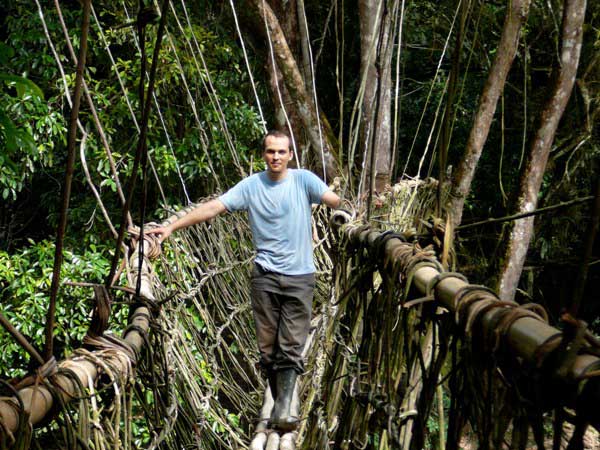Men in Cryptozoology: John-Mark Sheppard
Posted by: Loren Coleman on December 30th, 2007

John-Mark Sheppard (above) is the young man who is supplying cryptozoology with new insights about cryptids being reported in Liberia, e.g. the Gbahali and the Kumbway.
In response to reader requests for more about the person collecting the reports, I asked him to share some insights about himself.
Here is John-Mark Sheppard’s personal profile:
I am an American, 25 years old, single. I first came out to Liberia with my parents in 1986, and have spent most of my life between Liberia and Cote d’Ivoire. For the most part I have lived in rural areas of West Africa.
I can speak Liberian Pidgin English fluently, French passably, and I’ve recently been learning to speak the Mandingo language. I work in Liberia with a NGO called Samaritan’s Purse and oversee a program called Community Health Education (CHE). CHE is a grassroots program designed to help people take responsibility for their own health and development. We train people to be Community Health Educators who go an educate their family and neighbors about disease prevention and good sanitation. I have about a dozen Liberian staff working under me as trainers. I spend a good amount of my time in the remote areas in which my program operates. Spending time in these areas allows me the chance to explore Liberia’s great outdoors. I love hiking the many granite hills, and exploring the rivers here.
I’ve always been interested in biology to some level. When I was very young, it was dinosaurs, then I developed a fascination with orchids as a teenager, and later became interested in fish. Also growing up here, my siblings and I had the chance to rescue many orphaned animals. Over the course of about 18 years we, at one time or another, cared for over 70 species of animals including turtles, monitor lizards, crocodiles, mongooses, pottos, bush-babies, monkeys, civets, genets, duikers, pangolins, and numerous varieties of rodents. Although I don’t have much time for zoo keeping now, I still enjoy interacting with animals. Right now I have a pet potto, which is an African version of a loris.
I attached a picture of me on a “monkey bridge”. These are the traditional bridges people in rural areas use to cross rivers. They are made of vines and bamboo. They are very rare these days, so I was fortunate to be able to find over the upper part of the Kahai river.
The thought of documenting a previously undiscovered animal has fascinated me since I was a young boy. Growing up as a missionary kid in Liberia and Cote d’Ivoire, West Africa, I often spent my days exploring the forest around the towns were we lived, fishing, or searching for orchids. Besides loving dinosaurs, I read everything I could find about the Loch Ness Monster. I read stories about possible sauropod dinosaurs in Congo called Mokele-Membe and dreamed of one day leading an expedition to go find them. As I grew older the interest faded, although it never complete disappeared.
Furthering my studies in cryptozoology was certainly not one of my motivations for coming back to Liberia. However, due to some recent conversations I have had with my Liberian staff, my interest in finding undocumented creatures has been reignited. As incredible as this sounds, I firmly believe there are at least two species of “prehistoric” reptiles still living in the most remote areas of Northern Liberia. ~ John-Mark Sheppard
About Loren Coleman
Loren Coleman is one of the world’s leading cryptozoologists, some say “the” leading living cryptozoologist. Certainly, he is acknowledged as the current living American researcher and writer who has most popularized cryptozoology in the late 20th and early 21st centuries.
Starting his fieldwork and investigations in 1960, after traveling and trekking extensively in pursuit of cryptozoological mysteries, Coleman began writing to share his experiences in 1969. An honorary member of Ivan T. Sanderson’s Society for the Investigation of the Unexplained in the 1970s, Coleman has been bestowed with similar honorary memberships of the North Idaho College Cryptozoology Club in 1983, and in subsequent years, that of the British Columbia Scientific Cryptozoology Club, CryptoSafari International, and other international organizations. He was also a Life Member and Benefactor of the International Society of Cryptozoology (now-defunct).
Loren Coleman’s daily blog, as a member of the Cryptomundo Team, served as an ongoing avenue of communication for the ever-growing body of cryptozoo news from 2005 through 2013. He returned as an infrequent contributor beginning Halloween week of 2015.
Coleman is the founder in 2003, and current director of the International Cryptozoology Museum in Portland, Maine.










Bravo to Sheppard for his work, I hope to soon see some evidence of the two prehistoric beasts he believes exist in the wild!
Great story on John-Mark. It sounds like he had a very interesting and adventurous childhood.
I love the bridge.
I wish John-Mark the best of luck. There’s a chance he might be a rising face that manages to get something big.
Great to see a young man with such an interest in Unknown animals
Fascinating story.
I wonder what bush babies are.
So it sounds like there might be two undiscovered reptiles and one giant pangolin?
I wish him good luck, in both his cryptozoologic and aid based pursuits!
Kool! And good luck on your adventures John-Mark. I hope you find what your looking for.